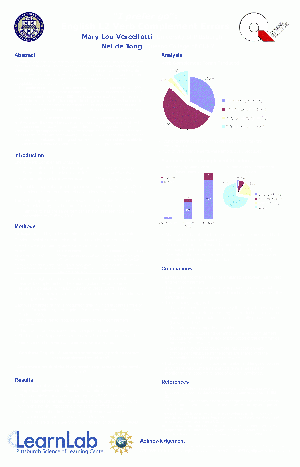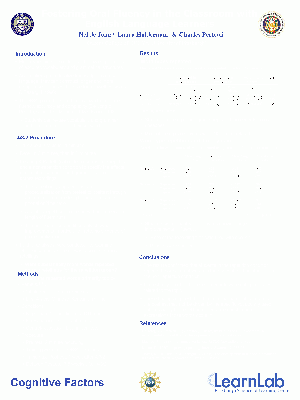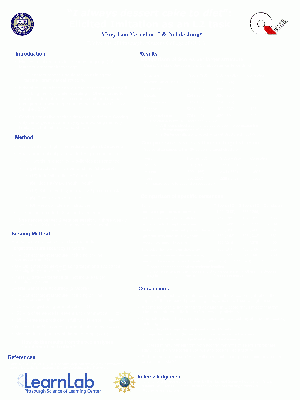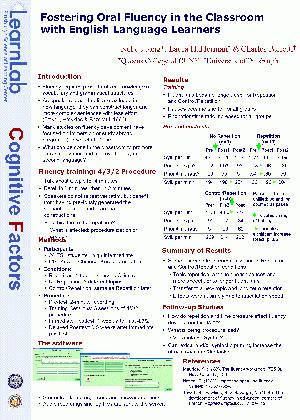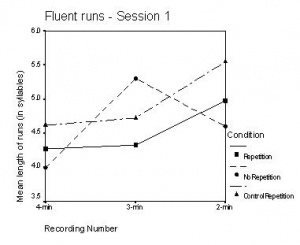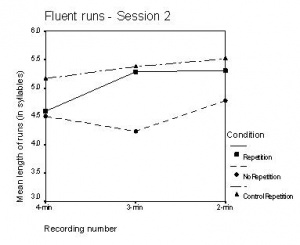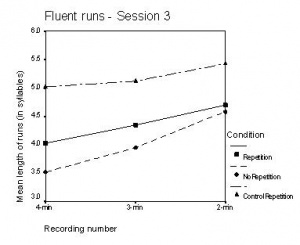Difference between revisions of "Fostering fluency in second language learning"
(→Study 4: The role of vocabulary and grammar in L2 fluency) |
(→Study 4: The role of vocabulary and grammar in L2 fluency) |
||
| Line 253: | Line 253: | ||
For relative clauses and plurals (and perhaps some other forms), grammatically correct and incorrect forms appear to be seen as two acceptable alternatives, as indicated by the large difference between grammatically correct and incorrect stimuli. For these items, the low scores for incorrect stimuli were almost complementary to high scores for correct stimuli: 70-30%, and 70-15%). | For relative clauses and plurals (and perhaps some other forms), grammatically correct and incorrect forms appear to be seen as two acceptable alternatives, as indicated by the large difference between grammatically correct and incorrect stimuli. For these items, the low scores for incorrect stimuli were almost complementary to high scores for correct stimuli: 70-30%, and 70-15%). | ||
| + | |||
| + | |||
| + | ''Linguistic knowledge and oral fluency'' | ||
| + | |||
| + | '''Pretest''' | ||
| + | |||
| + | Students with greater grammatical ability and deeper vocabulary knowledge spoke with longer fluent runs and higher articulation rates. In addition, students with a greater breadth of vocabulary used longer pauses and filled less time with speech. This finding is surprising. It is possible that students with larger vocabularies tried to use more words and more infrequent words, which led them to speak with lower fluency. This deserves further investigation. Finally, students whose lexical retrieval was faster were able to produce more syllables per minute of speech. | ||
| + | |||
| + | '''Posttest''' | ||
| + | |||
| + | Students with greater grammatical ability spoke with higher articulation rates. Students with a greater breadth of vocabulary knowledge used shorter pauses and filled more time with speech. This finding was expected, but opposite to the pretest. Here, it seems that students with larger vocabularies were able to find words more easily, leading to higher fluency. Finally, students whose lexical retrieval was faster were able to produce more syllables per minute of speech. | ||
| + | |||
| + | Overall, grammatical ability seems to lead to higher articulation rate. Vocabulary depth is related to longer fluent runs and higher articulation rates, whereas findings for vocabulary breadth are variable, leading to longer or shorter pauses and more or less time filled with speech. Faster lexical retrieval is associated with a higher number of syllabes per minute of speech. | ||
=== Study 3: Shadowing and formulaic sequences === | === Study 3: Shadowing and formulaic sequences === | ||
Revision as of 13:54, 25 January 2010
| Project title | Fostering fluency in second language learning: Testing two types of instruction |
|---|---|
| Principal Investigator | Dr. N. de Jong (faculty, Vrije Universiteit Amsterdam) |
| Co-PIs | Dr. L.K. Halderman (post-doc, University of Pittsburgh) |
| Dr. C.A. Perfetti (faculty, University of Pittsburgh) | |
| Others with > 160 hours | Claire Siskin, Jessica Hogan, John laPlante, Mary Lou Vercellotti |
| Study start and end dates | Study 1: September - November 2006 |
| Study 2: January - March 2007 | |
| Study 3: January - March 2007 | |
| Study 4: January - March 2008 | |
| Study 5: September - November 2008 | |
| Study 6: October - December 2009 | |
| Learnlab | ESL, Speaking courses (levels 3, 4, 5) |
| Number of participants | 250 |
| Total Participant Hours | 700 hours |
| Datashop | Audio files and transcriptions of Studies 1 through 4 are available |
| Current status | (December 2009) Paper about study 1 is accepted for publication; Papers about studies 2 and 4 are in preparation. Some results have been presented at conferences.
Transcription of Studies 5 and 6 is in progress. |
Contents
- 1 Abstract
- 2 Glossary
- 3 Research questions
- 4 Background and significance
- 5 Dependent variables
- 6 Independent variables
- 7 Hypotheses
- 8 Findings
- 8.1 Study 1: Repetition, proceduralization and L2 fluency
- 8.2 Study 2: Formulaic sequences
- 8.3 Study 3: Shadowing and formulaic sequences
- 8.4 Study 4: The role of vocabulary and grammar in L2 fluency
- 8.5 Study 3: Shadowing and formulaic sequences
- 8.6 Study 5: Priming vocabulary and grammar for fluent production
- 8.7 Study 6: Piloting picture story prompts
- 9 Explanation
- 10 Further information
- 11 Descendants
- 12 Annotated bibliography
- 13 PSLC-related publications and presentations
- 14 Screen shots
Abstract
Many studies have investigated the effect of exposure to language on fluency. It has been established, for instance, that fluency increases after a period of immersion or study abroad (Freed et al., 2004; Segalowitz & Freed, 2004). However, few types of instruction have been designed to increase oral fluency, and even fewer have been tested.
One such type of instruction is Nation’s 4/3/2 procedure, in which learners prepare a four-minute talk and repeat it twice to different partners, first in three minutes, then in two minutes (Nation, 1989). He found that the number of hesitations decreased in the retellings, and that sentences were more complex. We may characterize such an outcome as resulting from the fluency pressure exerted by the 4/3/2 procedure. It was not investigated, however, whether the effect transferred to new speeches, which is what we showed in Study 1. Another task that may increase fluency is shadowing, in which student talk along with a recording of a short speech by a native speaker. Shadowing may also increase the feature strength of formulaic sequences, resulting in faster access to them in subsequent production tasks.
This project is transformative in the sense that it moves research on fluency away from single- or multiple-case studies, using technology to collect and analyze larger amounts of oral production data (30 to 40 students per study), and to generate multiple measures of fluency, accuracy, and complexity. For example, not only articulation rate is measured, but also pause length, length of fluent run, and phonation/time ratio.
Study 1 investigated what characteristics of fluency are affected by the 4/3/2 procedure. Measures included the number of syllables per second (speech rate); mean length of fluent runs between pauses; phonation/time ratio; number of interphrasal and intraphrasal pauses; morphosyntactic accuracy; and number of embedded clauses (syntactic complexity). The posttest tested transfer to a different topic.
In Study 2 we investigated whether fluency is further enhanced by a pretraining of formulaic sequences, like the point is that, what I’m saying is that, and and so on). Fast and effortless access to these sequences frees up cognitive headroom which can then be used to construct sentences. This results in fewer and shorter pauses, and/or greater lexical and structural complexity.
Study 3 investigated whether shadowing leads to increased use of formulaic sequences (chunking) and native-like pauses in subsequent production tasks.
In studies 4 and 5 are investigating in further detail how the characteristics of the 4/3/2 task lead to fluency development. In Study 4a, we investigated how time pressure affects the benefits of repetition in terms of fluency, accuracy and complexity. We examined recordings both from the 4/3/2 task itself, and from long-term retention tests. In addition, we investigated the role of specific knowledge components in fluency development.
In Study 4b we tracked how the control and retrieval of specific vocabulary items and morphosyntactic structures develop as a result of the 4/3/2 training. Next, in Study 5, we examined whether priming these same items leads to greater accuracy and fluency during training and later. Data collection for Studies 4a, 4b and 5 took place in the Spring and Fall 2008 semesters, in the English as a Second Language (ESL) learnlab (level 4, higher intermediate). Data analysis is currently in progress.
(Posters presented in Spring 2009 are shown on the right. Click on the thumb images to see the larger images.)
Glossary
- 4/3/2 procedure
- A teaching method in which students talk about a topic for four minutes. Then they repeat their speech in three minutes, and again in two minutes.
- Shadowing
- Repeating speech while it is being spoken.
- Formulaic sequence
- A sequence, continuous or discontinuous, of words or other elements, which is, or appears to be, prefabricated (see Wray, 2002, p. 9), e.g., The point is that, What I'm trying to say is that, and Take something like.
- Articulation rate
- Number of syllables per second
- Phonation/time ratio
- The percentage of time spent speaking as a percentage proportion to the time taken to produce the speech sample
- Morphosyntactic accuracy
- In this study we will investigate subject-verb agreement, tense errors, definite/indefinite articles
- Syntactic complexity
- In this study we will investigate the number of embedded finite and non-finite clauses
Research questions
- Study 1:
- a. What characteristics of fluency are affected by repetition of a short speech under increasing time pressure (the 4/3/2 procedure)?
- b. Does knowledge refinement take place during the 4/3/2 training, in terms of morphosyntactic accuracy and syntactic complexity?
- Study 2:
- Study 3:
For studies 2 and 3, questionnaire data were collected about the students' contact with the second language (English) and their first language, in terms of types of contact (e.g., listening to the radio, talking to friends, talking to strangers) and amount of contact (number of days per week, number of hours per day). We will explore whether these individual differences affect pretest performance and fluency development.
- Study 4:
- a. How do time pressure and repetition affect fluency, accuracy and complexity in the 4/3/2 task?
- b. Which knowledge components contribute to fluency development in the 4/3/2 task?
- Study 5:
- Does priming lead to an immediate and a long-term increase in fluency, accuracy and complexity?
Background and significance
Many studies in the field of second language acquisition that have studied fluency have investigated the effect of study abroad, immersion and regular classroom practice on fluency (Freed, Segalowitz, and Dewey, 2004; Segalowitz & Freed, 2004). Very few studies, however, have investigated specific activities that lead to fluency, which can be done in classrooms. Two such activities are tested in this project.
The first activity that is tested is the 4/3/2 procedure as proposed by Nation (1989). He investigated the development of fluency during this task, but used a limited number of measures and did not test the long-term effect: he only analyzed fluency during the task itself, not during the following weeks. This project will test the long-term effect and will include more measures, such as length and location of pauses. An attempt will be made to link these measures to cognitive mechanisms.
A general effect of the 4/3/2 task on fluency development was found in Study 1. The effect was investigated in more detail in Study 4a, focusing on the two main characteristics of the task: repetition and increasing time pressure.
The contribution of knowledge components is tested in Studies 2, 4b and 5. In Study 2, students received a pretraining of a set of formulaic sequences before the first 4/3/2 fluency training session. In Study 5 students received a pretraining at the start of each 4/3/2 fluency training session. The knowledge components in this pretraining was selected based on the results of Study 4b, which investigated the role of vocabulary breadth, vocabulary depth and grammatical knowledge in oral fluency.
Study 3 investigated whether shadowing affected fluency development. In addition, it was tested whether the presence of formulaic sequences in the model speeches increased use of those sequences in later speaking tasks, and whether such an increase affected fluency measures.
Dependent variables
- Temporal measures of fluency:
- Articulation rate: number of syllables per second
- Pauses:
- mean length of fluent runs between pauses
- mean length of pauses
- phonation/time ratio
- number of interphrasal and intraphrasal pauses
- Formulaic sequences: number of appropriate formulaic sequences repeated from training
- Accuracy: morphosyntactic accuracy (target-like use of several structures, including subject-verb agreement, tense errors, and definite/indefinite articles; see Mizera, 2006: 71)
- Complexity: number of embedded finite and non-finite clauses (cf. Nation, 1989); lexical variety as measured by the Mean Segmental Type-Token Ratio (Towell, Hawkins & Bazergui, 1996)
- Near transfer, immediate and delayed, normal post-test: After completing the last training session, students performed a similar task (spontaneous speech about a given topic), to test whether any gains in fluency during the training task were maintained in a new instance of the same task. This test was given one week and four weeks after the last training session, each time with a different topic. These recordings were made as part of the Recorded Speaking Activities (RSAs) from the project "The self-correction of speech errors (McCormick, O’Neill & Siskin)".
- Far transfer, delayed: The delayed posttests in Study 4 will include measures of vocabulary breadth, vocabulary depth and grammatical knowledge.
Independent variables
(For screenshots exemplifying some of the independent variables, see Screenshots below.)
- Studies 1-3: Pretest vs. immediate posttest vs. long-term retention posttest
- Study 1: Repetition vs. No Repetition
- In the Repetition condition students talk about one topic three times. In the No Repetition condition, students talk about three different topics.
- Study 2:
- a. Pretraining vs. no pretraining of formulaic sequences
- In the Formulaic Sequences condition, students receive a short training of a number of formulaic sequences before they start the fluency training (4/3/2 task). In the No Formulaic Sequences condition, students do not receive this pretraining, and only do the 4/3/2 task.
- b. Low intermediate vs. high intermediate proficiency level
- Low intermediate students are enrolled in ELI Speaking courses at level 3, high intermediate at level 4.
- Study 3: Shadowing text with formulaic sequences vs. without formulaic sequences
- In the Formulaic Sequences condition, students shadow texts that contain formulaic sequences. In the No Formulaic Sequences condition, students shadow the same texts, from which the formulaic sequences that are being studied have been removed.
- Study 4:
- a. Repetition vs. No Repetition
- The 4/3/2 task will include either 1 topic (repeated) or 3 topics (not repeated)
- b. Increasing Time Pressure vs. No Increasing Time Pressure
- The 4/3/2 task will include recordings of either 4, 3 and 2 minutes, or 3, 3, and 3 minutes
- Study 5: Pretraining vs. no pretraining of vocabulary and grammar knowledge components
- In the Pretraining condition, students perform short tasks before the 4/3/2 training sessions to prime their vocabulary and grammar knowledge. Students in the No Pretraining condition do not receive this pretraining.
Hypotheses
- Study 1: It is hypothesized that repetition of a short speech (independent variable) under increasing time pressure (fluency pressure) increases articulation rate and sentence complexity (dependent variables), and decreases the number and length of pauses (dependent variables). The reason is that repetition will--temporarily--increase the availability of vocabulary and sentence structures (leading to increase speech rate, short and fewer pauses), leaving more cognitive headroom for other processes (higher accuracy and syntactic complexity).
- Study 2: It is hypothesized that the presence of a pretraining of formulaic sequences (independent variable) leads to an increase in their use in subsequent spontaneous speech (dependent variable). Effortless use of these sequences will free up cognitive headroom for sentence structure planning, which may lead to overall more fluent performance, in terms of speed and pausing patterns (dependent variables). Thus, the training of formulaic sequences may accelerate future learning.
- Study 2: Students at different proficiency levels may benefit in different ways from the 4/3/2 training. At lower proficiency levels, repetition may facilitate the use of particular words and grammar, leading to more instances of correct usage of vocabulary, morphosyntax and syntax. At higher proficiency levels, on the other hand, repetition may lead to a greater number of reformulations resulting in higher complexity.
- Study 3: It is hypothesized that shadowing a speech that contains formulaic sequences (independent variable) leads to an increase in their use in subsequent spontaneous speech (dependent variable). Since effortless use of these sequences will free up headroom for sentence structure planning, performance may become more fluent overall, in terms of speed and pausing patterns (dependent variables). Thus, shadowing may accelerate future learning. In addition, shadowing a text with target-language pausing patterns is expected to lead to a more native-like pausing pattern in subsequent spontaneous speech, mainly in terms of position (dependent variables: interphrasal and intraphrasal pauses).
- Study 4a: We hypothesize that time pressure in combination with speech repetition encourages a strategy of retrieval (shorter pauses, high lexical overlap between two subsequent recordings), while repetition without time pressure encourages computation, leading to higher accuracy and complexity with lower fluency. We expect that the strategy of computation may result in higher fluency in the longer term, because it leads to more refinement and strengthening of knowledge components, thus reducing hesitations and accelerating retrieval in future speeches (cf. the assistance dilemma).
- Study 4b: We hypothesize that students with a broader vocabulary—-since they have more words to choose from—-will be able to find an appropriate word more often and more quickly, and therefore speak more fluently (shorter and fewer pauses, fewer hesitations). This is a measure of individual differences, and of general vocabulary knowledge. Greater vocabulary depth will also increase fluency, because students have more control over vocabulary items. In addition, it is predicted that retrieval speed for words used in the fluency training will show a increase in retrieval speed compared to items that were used in the fluency training. Finally, we expect to find a positive correlation between fluency in speech production and the accuracy scores on a test of morphosyntactic knowledge.
- Study 5: We hypothesize that the pretraining will lead to more fluent speech production, as well as more accurate and more complex output. We expect that this effect will be retained on the posttest and delayed posttest. This would be an example of accelerated future learning through feature focusing.
- Study 6: This is an exploratory pilot study to test instructions and prompts for a new study, which will focus on the effect of time pressure on fluency and fluency developement (cf. Study 4a). The new speaking prompts will be picture stories, in order to create "pushed output" and to increase comparability of performance across students.
- Near transfer, immediate: In all studies, a posttest is administered about a week after the last training session. This will be a similar task—a 2-minute monologue—with new content—a new topic.
- Near transfer, retention: In Studies 1 and 2, another posttest is administered two to three weeks after the immediate posttest (three to four weeks after the last training session). Again, this will be a similar task—a 2-minute monologue—with new content—a new topic.
- Acceleration of future learning: In Study 5, the students in the experimental condition first receive a pretraining of a number of formulaic sequences. It will be tested whether their fluency, accuracy and syntactic complexity increases more during subsequent training, than of students who do not receive this pre-training.
Findings
Study 1: Repetition, proceduralization and L2 fluency
Fluency during the 4/3/2 task
During each training session, the mean length of fluent runs increased mostly for the two conditions in which speeches were repeated (Repetition and Control/Repetition). In addition, for all three groups, pauses, on average, became shorter, and phonation/time ratio increased (i.e., students were able to fill more time with speech).
Figures 1, 2 and 3 show the mean length of fluent runs for each recording in each of the sessions. It is clear that in sessions 1 and 2 the two conditions in which speeches were repeated pattern more closely together than the condition in which speeches were not repeated. The improvement in performance of the two repetition conditions seems more stable, whereas the performance of the No Repetition condition seems to be influenced by the topic of a particular speech.
Transfer to new topics
On the immediate posttest, students in the Repetition condition are able to produce the same length of fluent runs with shorter pauses. Also, they fill relatively more time with speech (increased phonation/time ratio). It seems, therefore, that they speak more fluently than students in the No Repetition condition. However, on the delayed posttest, the No Repetition condition seems to have caught up with the Repetition condition, also having shorter pause lengths, with stable lengths of fluent runs.
Both groups reach a higher articulation rate, measured in syllables per minutes, on the delayed posttest. This may have been due to their continued Speaking classes in the English Language Institute, and may not have been related to this study.
It should be noted that the posttests were administered one and four weeks after the last session of the fluency training, and involved a new topic, which the students had not talked about during the 4/3/2 training.
| No Repetition (n=9) | Repetition (n=10) | Control&Repetition (n=5) | |||||||||
|---|---|---|---|---|---|---|---|---|---|---|---|
| Pretest | Immediate | Delayed | Pretest | Immediate | Delayed | Pre-pretest | Pretest | Immediate | |||
| Posttest | Posttest | Posttest | Posttest2 | Posttest | |||||||
| Length of fluent runs (in syllables) * | 4.42 | 4.11 | 4.27 | 4.42 | 4.82 | 4.69 | 4.58 | 4.80 | 5.44 | ||
| Pause length (in sec.) * | 0.92 | 1.08 | 0.96 | 1.18 | 0.96 | 0.99 | 0.99 | 0.97 | 0.84 | ||
| Phonation/time ratio * | 0.59 | 0.55 | 0.57 | 0.54 | 0.60 | 0.59 | 0.57 | 0.59 | 0.62 | ||
| Syllables per minute | 194 | 190 | 204 | 196 | 196 | 204 | 209 | 214 | 232 | ||
* Significant interaction Condition x Time
Conclusion
The results of Study 1 suggest that knowledge becomes more easily accessible in subsequent speeches, since phonation/time ratio increases while pauses on average become shorter and the length of fluent runs is at least stable. In the two conditions in which speeches are repeated, the length of fluent runs increases, indicating an advantage over the no-repetition condition, in which this length is stable. It seems, therefore, that repeating a speech about a particular topic enables students to produce longer fluent runs. The overall advantage of these two conditions over the no-repetition condition parallels patterns in the pre- and posttest data.
Overall, it seems that the performance of the no-repetition condition was more variable across speeches. This may be due to an effect of topic, which may be more or less familiar, complex, or linguistically difficult (e.g., eliciting present vs. past tense).
Study 2: Formulaic sequences
A pretraining of ten formulaic sequences led to an increase in their use during the 4/3/2 procedure. However, students often used the sequences incorrectly, and some students used them more than others. There was very little transfer to other speaking tasks. The use of formulaic sequences had a mixed effect on fluency, in that it led to longer fluent runs (higher fluency) but also longer pauses (lower fluency). The trained formulaic sequences were probably not stored as chunks, and retrieval was not automatized Interestingly, after the pretraining students used more formulaic sequences that were not trained, as compared to the pretest and the students who had not received the pretraining. This is likely to be due to increased awareness of the existence and usefulness of formulaic sequences. These sequences with used with high accuracy. Overall, it seems that the use of formulaic sequences was not effortless, and had a mixed effect on fluency. The form errors suggest that the students had learned formulaic sequences at the word level, and did not store and retrieve them as chunks (cf. Towell et al., 1996; Wray, 2002).
Study 3: Shadowing and formulaic sequences
Data transcribed and coded. Analyses in progress.
Study 4: The role of vocabulary and grammar in L2 fluency
Breadth of productive vocabulary: Picture Naming accuracy
Accuracy improved from pretest (74.2%) to posttest (85.7%), and was higher on the 1-1000 frequency band (85.7%) compared to the 2001-3000 frequency band (74.2%). There was a greater difference between the frequency bands in the Immediate naming condition compared to the Delayed naming condition. Therefore, naming lower-frequency words seems to be more difficult under time pressure (Immediate naming) than under no time pressure (Delayed naming).
Retrieval speed of vocabulary: Picture Naming response time
The Delayed naming condition was significant faster (1.046 seconds) compared to the Immediate naming condition (1.794 seconds). Only in the Delayed condition did reaction times improve from pretest (1.303 seconds) to posttest (0.670 seconds). These findings suggest that changes occurred over the course of the semester for the Delayed condition only. This may be due to improvements in articulation rate rather than lexical retrieval since lexical retrieval is executed prior to the cue to name. If improvements in lexical retrieval had occurred, there should have been a reduction in reaction time at the posttest for the immediate condition since immediate naming includes lexical retrieval and articulation rate.
Vocabulary depth and productive use: Vocabulary Knowledge Scale
Depth of knowledge for nouns was less affected by frequency than verbs. However, for high-frequency verbs, depth of knowledge was similar to that of nouns. These findings suggest that extra experience or enhanced instruction may be necessary for ESL students to acquire rich representations of low-frequency verbs. The scores for most categories (all nouns and high and mid frequency verbs) were on average around 4 ("I know this word. It means: ..."), which indicates that the students had good receptive depth of knowledge of these words, but were just short of productive knowledge. It seems therefore that these words were ready to be brought into productive use, but most were note in productive use yet, even the 2-3K words.
Productive grammatical ability: Elicited Imitation
"Grammatical ability" was tested with a range of forms and structures, morphosyntactic as well as syntactic, and less to more complex (earlier to later acquired). Elicited Imitation accuracy was marginally significantly higher on the posttest (50%) compared to the pretest (45%).
There were different patterns of performance across structures for the correct stimuli compared to the pattern observed for the incorrect stimuli. For correct stimuli, Relative Clauses and Plurals had among the best performance. However, when the stimuli were incorrect, subjects infrequently corrected them leading to poorer performance than expected given the high accuracy on the correct stimuli trials. Other structures like Regular Past Tense and Verb Complements were unaffected by the accuracy of the stimulus, showing no difference between the two conditions. The remaining structures (Embedded Questions, Indefinite Articles, Modals and Third Person –s) showed significantly better performance for the correct compared to the incorrect condition; however, performance on these structures relative to other structures was similar across accuracy conditions. On average students clearly had some knowledge of the grammatical items tested, because they were able to correctly repeat most of the correct stimuli. However, scores were fairly low, well below the 90% that is often used as a criterion for acquisition. Also, performance was strongly affected by ungrammatical stimuli, which shows that the students’ knowledge or processing of the grammatical items was variable. This poor performance was found both for grammatical forms and structures that are typically late acquired (e.g., third person –s, embedded questions) and relatively early acquired (e.g., noun plurals, regular past)
For relative clauses and plurals (and perhaps some other forms), grammatically correct and incorrect forms appear to be seen as two acceptable alternatives, as indicated by the large difference between grammatically correct and incorrect stimuli. For these items, the low scores for incorrect stimuli were almost complementary to high scores for correct stimuli: 70-30%, and 70-15%).
Linguistic knowledge and oral fluency
Pretest
Students with greater grammatical ability and deeper vocabulary knowledge spoke with longer fluent runs and higher articulation rates. In addition, students with a greater breadth of vocabulary used longer pauses and filled less time with speech. This finding is surprising. It is possible that students with larger vocabularies tried to use more words and more infrequent words, which led them to speak with lower fluency. This deserves further investigation. Finally, students whose lexical retrieval was faster were able to produce more syllables per minute of speech.
Posttest
Students with greater grammatical ability spoke with higher articulation rates. Students with a greater breadth of vocabulary knowledge used shorter pauses and filled more time with speech. This finding was expected, but opposite to the pretest. Here, it seems that students with larger vocabularies were able to find words more easily, leading to higher fluency. Finally, students whose lexical retrieval was faster were able to produce more syllables per minute of speech.
Overall, grammatical ability seems to lead to higher articulation rate. Vocabulary depth is related to longer fluent runs and higher articulation rates, whereas findings for vocabulary breadth are variable, leading to longer or shorter pauses and more or less time filled with speech. Faster lexical retrieval is associated with a higher number of syllabes per minute of speech.
Study 3: Shadowing and formulaic sequences
Data transcribed. Coding in progress.
Study 5: Priming vocabulary and grammar for fluent production
Data transcribed. Coding in progress.
Study 6: Piloting picture story prompts
Explanation
This project is part of the Refinement and Fluency cluster. The studies in this cluster concern the design and organization of instructional activities to facilitate the acquisition, refinement, and fluent control of critical knowledge components. The general hypothesis is that the structure of instructional activities affects learning. This project addresses the core issues of task analysis, fluency from basics, in vivo evaluation, and scheduling of practice. The 4/3/2 task has been analysed into its components. In Study 1, the effect of the component of repetition is investigated. Practice with the basic skills of using vocabulary and grammar is expected to increase fluency. This will be the case in the Repetition condition, where students have the opportunity to re-use the words, formulaic sequences and grammar in subsequent recordings. In Study 2, students are encouraged to use formulaic sequences that have been taught before training. In Study 3 it is investigated whether shadowing promotes the use of formulaic sequences in spontaneous speech. All three studies take place in an in vivo setting.
Further information
For a summer intern project in June and July 2007, Kara Schultz did a multiple case study of six students from Study 1. The project was a first step towards more in-depth analyses of the data of all three studies in the ESL fluency project, addressing the following research questions:
- Does the absence of the need to generate new semantic content in the two retellings during the 4/3/2 task free up headroom, resulting in changes in fluency, morphosyntactic accuracy, and complexity?
- If so, what types of changes occur, and what are the causes for these changes?
- Is there long-term retention of the changes (one week)?
In September 2007 the PSLC executive committee approved our new project plan, in which we proposed follow-up studies that investigate the effect of time pressure and the role of specific knowledge components (vocabulary, grammar) in oral fluency. These studies will be run in the Spring and Fall semesters of 2008.
Publications
De Jong, N., and Perfetti, C.A. (to appear). Fluency training in the ESL classroom: An experimental study of fluency development and proceduralization.
Peer-reviewed presentations
De Jong, N., Halderman, L.K., & Ross, M., The effect of formulaic sequences training on fluency development in an ESL classroom. Paper presented at the American Association for Applied Linguistics conference 2009, Denver, CO, March 2009.
Vercellotti, M.L. & De Jong, N., “I prefer go”: English L2 verb complement errors. Poster presented at the Georgetown University Round Table, Washington, D.C., March 2009.
De Jong, N., McCormick, D., O'Neill, C., and Bradin Siskin, C., Self-correction and fluency in ESL speaking development. Paper presented at the American Association for Applied Linguistics 2007 Conference in Costa Mesa, California, April 2007.
See also: Descendants > Fluency Summer Intern Project 2008
Other presentations
De Jong, N., Oral fluency training in ESL. Talk given at the Pittsburgh Science of Learning (PSLC) monthly meeting, July 20, 2009.
De Jong, N., Pre-training formulaic sequences and its effect on oral fluency. Talk given at the SLA lab meeting, CUNY Graduate Center, April 24, 2009.
Vercellotti, M.L. & De Jong, N., “I always dessert cake to diet”: Elicited Imitation as an L2 task. Poster presented at the Second Annual Inter-Science of Learning Center Conference, Seattle, WA, February 2009.
De Jong, N., The study of oral fluency development in ESL. Presentation given at the Colloquium on Teaching and Learning World Languages, Queens College of CUNY, March 2008.
De Jong, N., Approaches to the study of second language acquisition. Guest lecture at the CUNY Graduate Center (invited by Prof. Den Dikken and Prof. Otheguy), December 2007
De Jong, N., Oral fluency development in ESL classrooms. Guest lecture at the CUNY Graduate Center (invited by Prof. Klein), November 2007
De Jong, N., Presentation of the software component at the Multimedia Showcase sponsored by the Robert Henderson Media Center at the University of Pittsburgh, September 2006
Descendants
Fluency Summer Intern Project 2007 -- Kara Schultz
Fluency Summer Intern Project 2008 -- Megan Ross
Fluency Summer Intern Project 2009 -- Maya Randolph
Explicit and implicit knowledge of infinitival and gerundival verb complements in L2 speech
Annotated bibliography
Nation, I.S.P. (1989). Improving speaking fluency. System, 17, 377-384.
- Studied the 4/3/2 task. Did not distinguish between effect of speech repetition and time pressure.
Freed, B. F., Dewey, D. P., Segalowitz, N., & Halter, R. (2004). The Language Contact Profile. Studes in Second Language Acquisition, 26, 349-356.
- Developed a questionnaire about out-of-class language contact. Used in Study 2 and 3.
Freed, B. F., Segalowitz, N., & Dewey, D. P. (2004). Context of learning and second language fluency in French: Comparing regular classroom, study abroad, and intensive domestic immersion programs. Studies in Second Language Acquisition, 26, 275-301.
- Used the Language Contact Profile questionnaire. Studied fluency development as a result of study abroad and immersion.
Mizera, G. J. (2006). Working memory and L2 oral fluency. Unpublished doctoral dissertation. University of Pittsburgh, Pittsburgh.
- Includes an investigation of native speaker ratings of oral fluency.
Segalowitz, N., & Freed, B. F. (2004). Context, contact, and cognition in oral fluency acquisition. Studies in Second Language Acquisition, 26, 173-199.
- Studied fluency development as a result of study abroad.
Towell, R., Hawkins, R., & Bazergui, N. (1996). The development of fluency in advanced learners of French. Applied Linguistics, 17, 84-119.
- Argued that proceduralization of linguistic knowledge shows up in second language speech as longer fluent runs with stable or improving pause length and phonation/time ratio.
* Images available at top of page
De Jong, N. & Perfetti, C.A. (under revision). Fluency training in the ESL classroom: An experimental study of fluency development and proceduralization.
De Jong, N. (2009). Pre-training formulaic sequences and its effect on oral fluency. Talk given at the SLA lab meeting, CUNY Graduate Center, April 24, 2009.
De Jong, N., Halderman, L.K., & Ross, M. (2009). The effect of formulaic sequences training on fluency development in an ESL classroom. Paper presented at the American Association for Applied Linguistics conference 2009, Denver, CO, March 2009.
* Vercellotti, M.L. & De Jong, N. (2009). “I prefer go”: English L2 Verb Complement Errors. Poster presented at the Georgetown University Round Table, Washington, D.C., March 2009.
* Vercellotti, M.L. & De Jong, N. (2009). “I always dessert cake to diet”: Elicited Imitation as an L2 task. Poster presented at the Second Annual Inter-Science of Learning Center Conference, Seattle, WA, February 2009.
De Jong, N. (2008). The study of oral fluency development in ESL. Presentation given at the Colloquium on Teaching and Learning World Languages, Queens College of CUNY, March 2008.
De Jong, N. (2008). Oral fluency development in a second language. Presentation given at the Cognitive Approaches to Second Language Acquisition research group at the University of Amsterdam, January 2008.
De Jong, N., (2007). Approaches to the study of second language acquisition. Guest lecture at the CUNY Graduate Center, December 2007.
De Jong, N., (2007). Oral fluency development in ESL classrooms. Guest lecture at the CUNY Graduate Center, November 2007.
De Jong, N., McCormick, D., O'Neill, C., and Bradin Siskin, C., (2007). Self-correction and fluency in ESL speaking development. Paper presented at the American Association for Applied Linguistics 2007 Conference, Costa Mesa, California, April 2007.
De Jong, N., (2006) Developing oral fluency with the 4/3/2 task. Presentation given at the Multimedia Showcase, University of Pittsburgh, September 2006.
Screen shots
Screenshot of the screen where students take notes before they start speaking.
Screenshot of the screen where students record their speeches
Screenshot of some of the questions after each speech has been recorded.
